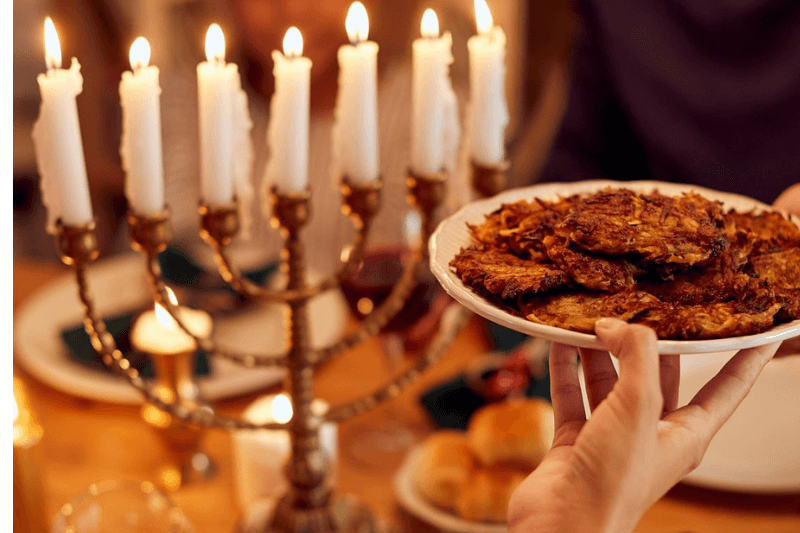
Hanukkah 2023: A Festival of Lights or Jewish Christmas?
Hanukkah, also spelled Chanukah, stands as Judaism’s beloved “Festival of Lights,” a celebration steeped in rich traditions and symbolic significance. This article aims to unravel the essence of Hanukkah, exploring its history, rituals, and the diverse ways it is celebrated worldwide.
This year, Hanukkah will be celebrated from Dec. 7 through Dec. 15. The dates of the holiday are based on Hebrew month of Kislev, which usually coincides with November-December in the Gregorian calendar.
Hanukkah’s Illuminated History- ‘Jewish Christmas’
Hanukkah, derived from the Hebrew word meaning “dedication,” holds a central place in Jewish traditions. The festival commemorates the rededication of the Temple in Jerusalem during the 2nd century BC, a historic event following the liberation of a courageous group of Jewish fighters.
At the heart of this celebration lies the lighting of the menorah, a multi-branched candelabra. Each night for eight consecutive evenings, families gather to kindle one additional candle, symbolizing the miracle of a small supply of oil lasting eight days.
Keep Reading
When Hanukkah Illuminates the Calendar
The observance of Hanukkah is intricately tied to the Hebrew month of Kislev, typically aligning with November-December in the Gregorian calendar. In 2023, the festival will be celebrated from December 7 through December 15.
Diverse Observances Across Jewish Spectrum
Hanukkah bridges religious denominations within Judaism, with Reform, Conservative, and Orthodox Jews all uniting around the festival’s core theme: bringing light into darkness and acknowledging the transformative power of even small efforts.
While the Talmud reflects a historical dispute over the order of lighting, the universal practice involves starting with one candle and progressively increasing the illumination each night. The special menorah, featuring eight branches and a central ninth candle called shamash, witnesses the nightly ritual. Candles are added from right to left, but lit from left to right, always beginning with the newest light.
Hanukkah Beyond Homes: Illuminating Public Spaces
A captivating aspect of Hanukkah is the widespread display of menorahs. Beyond individual households, these symbolic candelabras find a place in city streets and parks, representing the spreading of divine light to all nations. In recent years, this public celebration has gained prominence globally, adorning public landmarks with the warm glow of Hanukkah.
A Deeper Look at Hanukkah’s Historical Roots
Often termed the “Jewish Christmas,” Hanukkah’s origins are distinct from the Christian celebration. It commemorates the rededication of the Second Temple in Jerusalem around 200 B.C. during the Maccabean Revolt. The Jews, rising against Greek-Syrian oppressors, reclaimed Jerusalem in 164 B.C.
A miraculous event unfolded as a jar of oil, sufficient for only a day, kept the menorah candles burning for eight days. Hence, Hanukkah spans eight days, with a candle lit each evening after dark.
The Menorah vs. Hanukkiah: Unveiling the Distinction
While commonly referred to as a menorah, the ceremonial object lit during Hanukkah is, in fact, the hanukkiah, a nine-branched candelabrum. The ninth branch holds the “helper” candle, shamash, used to light the other eight candles after reciting blessings (bracket).
The lunar calendar dictates the commencement of Hanukkah on the 25th day of Kislev, the ninth month in the Jewish calendar. This variance in the lunar and Gregorian calendars results in changing dates each year.
Hanukkah’s Evolution: From Solemnity to Commercial Festivity
Originally devoid of gift-giving traditions, Hanukkah has evolved into a more commercial celebration over the years. While rooted in historical significance, it has become customary, especially for children, to exchange gifts. Culinary delights like round jelly doughnuts (sufganiyot) and potato pancakes (latkes) add a flavorful dimension to the festivities.
Preserving Tradition Amidst Modernity
As Hanukkah continues to resonate as a festival of joy, resilience, and cultural pride, it stands at the intersection of tradition and modernity. The menorah’s glow not only illuminates homes but also serves as a beacon of unity, echoing the enduring spirit of the Jewish people.
In conclusion, Hanukkah unfolds as a tapestry of historical resilience, religious dedication, and cultural celebration. The festival’s timeless traditions echo across generations, inviting all to partake in the warmth of its lights and the richness of its heritage.

